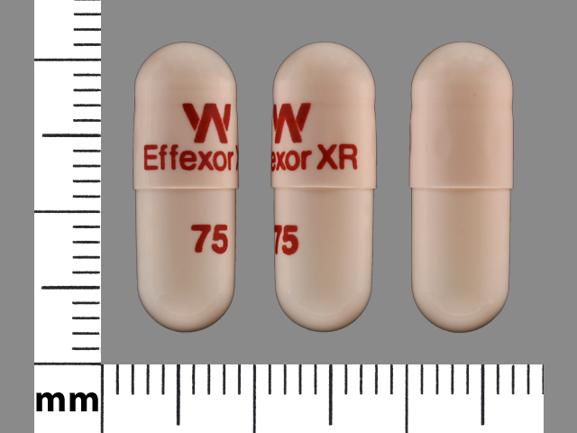Effexor XR Disease Interactions
There are 11 disease interactions with Effexor XR (venlafaxine).
- Depression
- Renal disease
- Renal/liver disease
- Mania
- Glaucoma
- Hypertension
- Hyponatremia
- Mania
- Seizures
- Urinary tract obstruction
- Weight loss
SNRI antidepressants (applies to Effexor XR) depression
Major Potential Hazard, Moderate plausibility. Applicable conditions: Bipolar Disorder
Adult and pediatric patients with depression and other psychiatric disorders may experience worsening of their symptoms and may have the emergence of suicidal thoughts and behavior. Patients should be monitored appropriately and observed closely for worsening of their symptoms, suicidality or changes in their behavior, especially during the first few months of treatment, and at times of dose changes. Discontinuing the medication should be considered if symptoms are persistently worse, or abrupt in onset. It may be prudent to refrain from dispensing large quantities of medication to these patients.
SNRI antidepressants (applies to Effexor XR) renal disease
Major Potential Hazard, Moderate plausibility. Applicable conditions: Renal Dysfunction
The clearance of SNRI antidepressants is decreased in subjects with renal impairment. SNRIs should be used with caution in this group of patients and a dose adjustment is recommended in those with moderate and severe renal impairment. The use of SNRIs is not recommended in patients with end-stage renal disease.
Venlafaxine (applies to Effexor XR) renal/liver disease
Major Potential Hazard, High plausibility. Applicable conditions: Renal Dysfunction
Venlafaxine is metabolized by the liver, and both the parent drug and metabolites are excreted by the kidney. Patients with renal and/or liver disease may be at greater risk for adverse effects from venlafaxine due to decreased drug clearance. Therapy with venlafaxine should be administered cautiously in patients with impaired renal and/or hepatic function. A reduction in the total daily dosage is recommended. The manufacturer suggests a 50% reduction in patients with moderate hepatic impairment (possibly more in patients with cirrhosis), a 25% reduction in patients with mild to moderate renal impairment, and a 50% reduction in patients undergoing hemodialysis (to be administered after dialysis treatment).
Antidepressants (applies to Effexor XR) mania
Moderate Potential Hazard, Moderate plausibility. Applicable conditions: Bipolar Disorder
All antidepressants may occasionally cause mania or hypomania, particularly in patients with bipolar disorder. Therapy with antidepressants should be administered cautiously in patients with a history of mania/hypomania.
SNRI antidepressants (applies to Effexor XR) glaucoma
Moderate Potential Hazard, Moderate plausibility. Applicable conditions: Glaucoma (Narrow Angle)
SNRI antidepressants cause pupillary dilation that may trigger an angle closure attack in patients with anatomically narrow angle without iridectomy.
SNRI antidepressants (applies to Effexor XR) hypertension
Moderate Potential Hazard, Moderate plausibility.
Selective serotonin and norepinephrine reuptake inhibitor antidepressants (SNRIs) have been associated with sustained increases in blood pressure. Therapy with SNRI antidepressants should be administered cautiously in patients with preexisting hypertension. Blood pressure should be assessed prior to initiating treatment and monitored regularly. The dose should be reduced or discontinued if necessary.
SNRI antidepressants (applies to Effexor XR) hyponatremia
Moderate Potential Hazard, Moderate plausibility. Applicable conditions: Dehydration
Treatment with SNRI antidepressants can cause hyponatremia. Caution should be used when treating patients with hyponatremia or at greater risk of hyponatremia such as the elderly, patients taking diuretics or who are volume depleted.
SNRI antidepressants (applies to Effexor XR) mania
Moderate Potential Hazard, Moderate plausibility. Applicable conditions: Bipolar Disorder
Therapy with SNRI antidepressants can cause activation of mania and hypomania and should be used with caution in patients with personal or family history of mania, hypomania, bipolar disorder, and other mood disorders.
SNRI antidepressants (applies to Effexor XR) seizures
Moderate Potential Hazard, Moderate plausibility.
SNRI antidepressants may trigger seizures and should be administered with caution in patients with a seizure disorder.
SNRI antidepressants (applies to Effexor XR) urinary tract obstruction
Moderate Potential Hazard, Moderate plausibility. Applicable conditions: Urinary Tract Infection
SNRI antidepressants have a noradrenergic effect and can affect urethral resistance. Caution should be used in patients with a history of dysuria, prostatic hypertrophy, prostatitis, and other lower urinary tract obstructive disorders.
Venlafaxine (applies to Effexor XR) weight loss
Minor Potential Hazard, Moderate plausibility. Applicable conditions: Weight Loss/Failure to Thrive, Anorexia/Feeding Problems, Malnourished
The use of venlafaxine may occasionally cause significant, dose-dependent weight loss, which may be undesirable in patients suffering from anorexia, malnutrition or excessive weight loss. The loss of at least 5% of body weight occurred in 6% to 7% of treated patients in premarketing studies, compared to 1% to 2% for placebo. Anorexia may occur in approximately 10% of patients. Weight change should be monitored during therapy if venlafaxine is used in malnourished or underweight patients.
Switch to professional interaction data
Effexor XR drug interactions
There are 700 drug interactions with Effexor XR (venlafaxine).
Effexor XR alcohol/food interactions
There are 2 alcohol/food interactions with Effexor XR (venlafaxine).
More about Effexor XR (venlafaxine)
- Effexor XR consumer information
- Check interactions
- Compare alternatives
- Pricing & coupons
- Reviews (1,012)
- Drug images
- Side effects
- Dosage information
- During pregnancy
- Generic availability
- Support group
- Drug class: serotonin-norepinephrine reuptake inhibitors
- Breastfeeding
- En español
Related treatment guides
Drug Interaction Classification
| Highly clinically significant. Avoid combinations; the risk of the interaction outweighs the benefit. | |
| Moderately clinically significant. Usually avoid combinations; use it only under special circumstances. | |
| Minimally clinically significant. Minimize risk; assess risk and consider an alternative drug, take steps to circumvent the interaction risk and/or institute a monitoring plan. | |
| No interaction information available. |
Further information
Always consult your healthcare provider to ensure the information displayed on this page applies to your personal circumstances.


